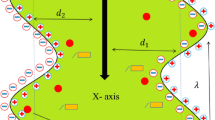Abstract
Surface-tension gradients, which can exist across autocatalytic chemical fronts propagating in thin layers of solution in contact with air, can induce capillary flows that are also called Marangoni flows. These flows in turn affect the spatio–temporal evolution of the concentration fields. This paper addresses the influence of the thickness of the solution layer on the chemo–hydrodynamic pattern resulting from such a coupling between autocatalytic reactions, diffusion and Marangoni effects, neglecting any buoyancy-driven effect. The system reaches an asymptotic dynamics characterized by a steady fluid vortex traveling at a constant speed with the front and deforming it. When the thickness of the fluid layer is increased, Marangoni effects are increasing, thus leading to a larger deformation of the chemical front, larger traveling speed, and more intense convection.
Similar content being viewed by others
References
De Wit A (2004). Miscible density fingering of chemical fronts in porous media: nonlinear simulations. Phys Fluids 16(1): 163–175
Böckmann M and Müller SC (2004). Coarsening in the buoyancy-driven instability of a reaction-diffusion front. Phys Rev E 70(4): 046302
Horváth D, Tóth Á and Bánsági T (2004). Nonlinear interactions in the density fingering of an acidity front. J Chem Phys 121(23): 11912–11915
Gribschaw TA, Showalter K, Banville DL and Epstein IR (1981). Chemical waves in the acidic iodate oxidation of arsenite. J Phys Chem 85: 2152–2155
Hanna A, Saul A and Showalter K (1982). Detailed studies of propagating fronts in the iodate oxidation of arsenous acid. J Am Chem Soc 104: 3838–3844
Bazsa G and Epstein IR (1985). Traveling waves in the nitric acid-iron(II) reaction. J Phys Chem 89: 3050–3053
Pojman JA and Epstein IR (1990). Convective effects on chemical waves: 1. Mechanisms and stability criteria. J Phys Chem 94: 4966–4972
Miike H, Yamamoto H, Kai S and Müller SC (1993). Accelerating chemical waves accompanied by traveling hydrodynamic motion and surface deformation. Phys Rev E 48: 1627–1630
Kai S and Miike H (1994). Hydrochemical soliton due to thermocapillary instability in Belousov–Zhabotinsky reaction. Physica A 204: 346–358
Kai S, Ariyoshi T, Inanaga S and Miike H (1995). Curious properties of soliton induced by Marangoni instability in shallow Belousov–Zhabotinsky reaction. Physica D 84(1–2): 269–275
Inomoto O, Ariyoshi T, Inanaga S and Kai S (1995). Depth dependence of the big wave in Belousov–Zhabotinsky reaction. J Phys Soc Jpn 64(10): 3602–3605
Inomoto O, Kai S, Ariyoshi T and Inanaga S (1997). Hydrodynamical effects of chemical waves in quasi-two-dimensional solution in Belousov–Zhabotinsky reaction. Int J Bif Chaos 7(5): 989–996
Hauser MJB and Simoyi RH (1994). Inhomogeneous precipitation patterns in a chemical wave. Phys Lett A 191(1–2): 31–38
Martincigh BS and Simoyi RH (1995). Convective instabilities induced by an exothermic autocatalytic chemical reaction. Phys Rev E 52(2): 1606–1613
Martincigh BS and Simoyi RH (2002). Pattern formation fueled by dissipation of chemical energy: conclusive evidence for the formation of a convective torus. J Phys Chem A 106(3): 482–489
Rongy L and De Wit A (2006). Steady Marangoni flow traveling with chemical fronts. J Chem Phys 124: 164705
Nepomnyashchy AA, Velarde MG, Colinet P (2002) Interfacial phenomena and convection. Chapman and Hall/CRC, Boca Raton
Merkin JH and Ševčiková H (1999). Travelling waves in the iodate–arsenous acid system. Phys Chem Chem Phys 1: 91–97
Field RJ, Burger M (eds) (1985) Oscillations and traveling waves in chemical systems. Wiley, New York
Author information
Authors and Affiliations
Corresponding author
Rights and permissions
About this article
Cite this article
Rongy, L., De Wit, A. Marangoni flow around chemical fronts traveling in thin solution layers: influence of the liquid depth. J Eng Math 59, 221–227 (2007). https://doi.org/10.1007/s10665-007-9144-8
Received:
Accepted:
Published:
Issue Date:
DOI: https://doi.org/10.1007/s10665-007-9144-8




